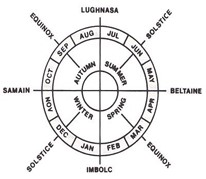A Change of Seasons: Out With the Cold, in With the Warm
Opinion Advocates for ideas and draws conclusions based on the author/producer’s interpretation of facts and data.
 By Brian McGowan
By Brian McGowan
It’s been a while since we visited the Celtic calendar. Time for a refresher on where we currently stand within it.
May 1, just recently past, marked the feast of Beltaine, one of the four major Celtic festival days. While prior articles have spoken of each of the four, there’s no time like the present for a quick reminder on what they are, when they occur and what their significance is. And since we’re already ensconced in the month of May, no better place to begin with than Beltaine.
The word is pronounced in a variety of ways, depending upon the source one draws from. My favorite is “BELL-tinnuh.” Why? I really don’t know. It rolls off the tongue a little easier than some others I have heard, including “Bal-HIN-nuh” or the phonetic “Bell-TAIN.” Take your pick.
In case you’ve forgotten, or are a new reader, the Celtic calendar is in the form of a wheel, and the year proceeds counterclockwise on its path. Key dates are the four great festivals and the equally important solstices.
Also of note, in the Celtic calendar there is no concept of our more modern-day seasons – winter, spring, summer and fall. To the Celts, there were only two seasons – the season of cold and the season of warmth.

The cold season begins with Samhain (Oct. 31-Nov. 1), extends through Imbolc (Jan. 31-Feb. 1) and ends with Beltaine (Apr. 30-May 1), which ushers in the warm season.
The fourth feast, that of Lughnasa (July 31-Aug.1), is the height of the Celtic year, smack-dab in the middle of the warm season. Love those rays of summer? Thank the Celtic god Lugh, who, while he greets you every morning throughout the year, shines his face upon you most favorably on the first of August.
Why, you may ask, do I show two dates for each festival? That is because to the Celts, the day did not start and end at midnight. It started, rather, at sunset, and ended with the next setting sun.
To many in today’s world, May is a favored month and delivers the promise of spring. Likewise, it held a special place for the Celts. It marked the beginning of the season of warmth, when their kine, or cattle, would begin their journey to summer pastures.
Cattle, along with horses, were the two most prominent possessions, whether an individual family or a larger clan. To protect this investment, great bonfires would be kindled during the night of Beltaine, often in pairs, and the beasts would be driven between them – harmlessly so – while family members danced around and across the embers. Hearth fires would be doused and then rekindled from the light of the Beltaine fires. A nod from the gods would be enough to ensure a good crop, plenty of calves and foals in the coming months, and good fortune for all.
We hopefully mark an equally opportune time as we head into our warm season, and transition from an age of pandemic to one of endemic. The scourge of COVID-19 remains, though its severity seems greatly reduced from what it was in early 2020.
Entertainment venues are reopening, including such Irish staples as the Irish Arts Center and the Irish Repertory Theatre. The Irish Rep just announced two new shows for the summer season on the main stage. They are “YES! Reflections of Molly Bloom,” from the novel “Ulysses” by James Joyce (June 8 through July 17) and “The Butcher Boy,” a musical (July 20 through Sept. 11). Currently you can see “Belfast Girls” through June 26.
The Irish Rep is located at 132 W. 22nd St. in Manhattan (between 6th and 7th Avenues). To purchase tickets online, visit irishrep.org.
And always remember, it’s never too late, you know, to invoke an older, if mainly sidelined, source of protection. While I can’t endorse lighting private bonfires (illegal, pretty much everywhere nowadays), there’s little harm in a casual nod to the ancients. Call it insurance!
Long-time Pleasantville resident Brian McGowan was born and raised in the Bronx and is a second-, third- and fifth-generation Irish-American/Canadian, as his immigrant ancestors followed several paths to the New World. Reach him at brian.m.mcgowan1952@gmail.com. He is the author of two books, “Thunder at Noon,” about the Battle of Waterloo, and “Love, Son John,” about World War II. Both are available at Amazon.com.

Examiner Media – Keeping you informed with professionally-reported local news, features, and sports coverage.

